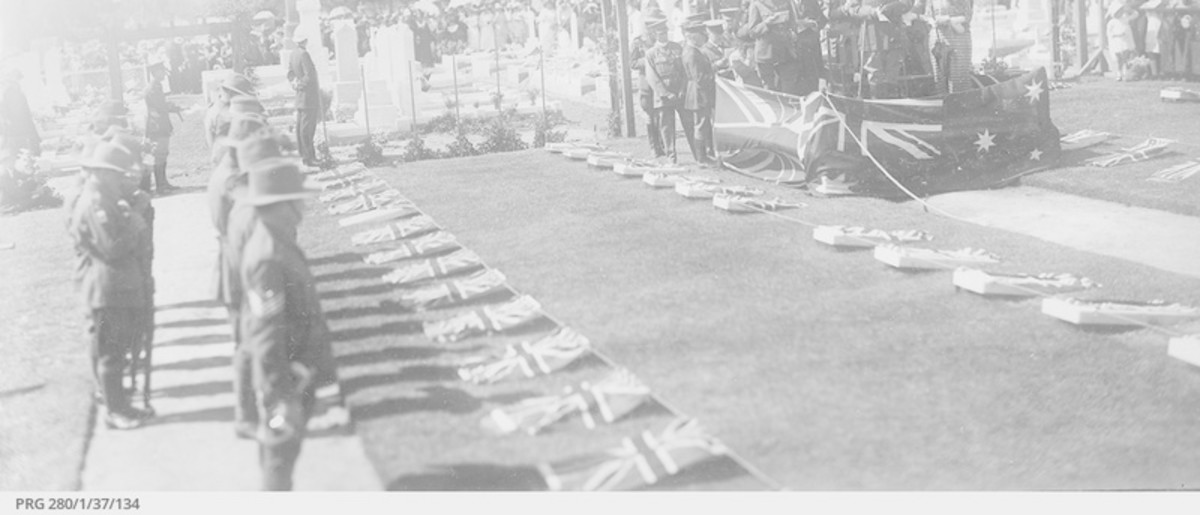Place
ContributeHeadstones
The graves within the cemetery, following the Commonwealth War Graves Commission's guidelines and belief that all soldiers should be honoured equally, are marked with uniform white marble headstones, 81cm in length, 38cm wide and 8cm thick, engraved with the AIF symbol. The headstones, lined in rows and placed horizontally across each grave, also contain the soldier's unit badge, number, name, battalion, place and date of death, age, a symbol of their faith and a family tribute. The unit badges, the only colour on the headstones, are rarely found in Australian war cemeteries.
Cross of Sacrifice
The Cross of Sacrifice, officially unveiled on 12 October 1924, was the first to be erected within an Australian burial ground. Designed by one of the Commonwealth War Graves Commission's architects, Sir Reginald Blomfield, the Cross is made of Angaston marble and decorated with a bronze crusader sword. Costing £1500, a gift from the Commonwealth Government, and standing 10.4 metres high, it dominates the cemetery landscape from its prominent position in the centre of Light Oval.
After it was erected, the Cross, covered by both the Union Jack and Australian Flag, was unveiled by the Governor-General Lord Forster in a ceremony at West Terrace Cemetery. He remarked in his speech:
As the years roll by...and as other generations pass hence, all the pain and the suffering and the sorrow of the Great War will vanish, and there will remain nothing but the fame and glory of the great deeds grandly done. Then shall this noble cross remind men of what we owe to those who lie buried here, and thus will it inspire successive generations with the same splendid spirit of service and self-sacrifice, which it commemorates. (The Observer 18 October 1924, p 31)
Extension and reorganisation of the cemetery
The cemetery, by 1924, contained the graves of 157 returned personnel within its quarter of an acre boundary. To accommodate more burials, It was extended in November 1944 to its current size of four acres. The new area, located directly behind Light Oval, was named Kendrew Oval after long-serving Chairman Reverend GW Kendrew. In the 1960s the cemetery was renovated and reorganised to its current arrangement. During these renovations, the headstones were placed upright into concrete plinths, new turf was laid and a new sprinkler system was put in place.
Closed for burials in 1994, the cemetery currently contains the graves of 4167 ex-service personnel, including the graves of four Victoria Cross recipients: Brigadier Arthur S Blackburn, Corporal Philip Davey, Sergeant RR Inwood and Corporal Jorgen C Jensen.
Media
Add mediaImages

Image courtesy of the State Library of South Australia, SLSA: PRG 280/1/37/134, public domain

Image courtesy of the State Library of South Australia, SLSA, Searcy Collection: PRG 280/1/40/299, public domain

Image courtesy of the State Library of South Australia, SLSA, Searcy Collection: PRG 280/1/30/28, public domain.



Comments
CommentAdd new comment
I'm sure the cemeteries are keeping a careful eye on the graves Carol. You can contact the West Terrace Cemetery directly for further information about the graves there - https://aca.sa.gov.au/our-cemeteries/west-terrace-cemetery
When first erected the headstones were all white and they are supposed to be white as across Europe. I don't know who has painteed the headstones or whether they have permission to do it. If they paint my grandfather's headstone I will lay charges for desigration of his grave. There are headstones in the AIF owned by War Games and last time I heard, which was about 6-7 years ago it was a Federal offence to damage or steal Federal property
Hi Jeff, I don't know the details of whether there have been any conservation decisions in this instance, but sometimes heritage recommendations are not to interfere with the original materials, to try and stabilise what is left rather than restore 'to new'.
The AIF Cemetery is part of West Terrace Cemetery http://www.aca.sa.gov.au/Our-Cemeteries/West-Terrace-Cemetery You may be able to find out more from the contact at that link.
Many of the war grave headstones are now close to unreadable as the black markings of the names have worn away. .Who is responsible for the remarking of the stones ?